Artificial intelligence has reshaped nearly every aspect of modern life, from how we communicate and shop to how we navigate cities and interact with machines. But in the business world, AI doesn't just enhance convenience; it redefines how organizations think, decide, and grow.
In 2025, enterprise AI has moved from experimentation to transformation. What once powered smart assistants and recommendation engines now sits at the core of how enterprises operate, compete, and deliver value. It's no longer about automating tasks; it's about enabling intelligent systems that perceive context, learn continuously, and make decisions with speed and precision.
This marks a pivotal shift for businesses. Enterprise AI today is engineered for scale, complexity, and strategic impact. It brings together technologies like machine learning, natural language processing, computer vision, and generative AI, embedding them across mission-critical systems to unlock real-time intelligence, proactive operations, and measurable outcomes.
Unlike siloed AI pilots of the past, today's enterprise AI is deeply integrated, powering predictive operations, personalized customer engagement, intelligent automation, and adaptive risk management. It doesn't just support processes; it transforms them.
In this blog, we'll unpack what enterprise AI truly means in 2025, how it's being architected and applied across industries, and why it's emerging as the digital backbone of modern enterprises. If you're evaluating where enterprise AI fits into your strategy or how to scale what you've already started, this is where clarity begins.
Defining enterprise AI in strategic business terms
Enterprise AI is the strategic intelligence layer powering today’s most agile, data-driven organizations. Like a digital nervous system, it senses, understands, and activates insights across every workflow, customer channel, and data stream. Its value lies not only in the models, but in how seamlessly it’s architected, governed, and aligned with generative AI strategy to deliver on real business priorities. From intelligent decision-making to operational precision, enterprise AI empowers leaders to scale clarity, speed, and performance across every level of the business.
What is enterprise AI: Intelligence embedded into the business
At its simplest, enterprise AI is the integration of intelligent capabilities, such as learning, reasoning, and natural language understanding, into the operational fabric of a business. It moves AI from isolated experimentation to embedded decision-making across workflows, platforms, and customer experiences.
Rather than adding AI as a feature, enterprise-grade solutions embed AI into the process itself, automating complex tasks, anticipating outcomes, and continuously improving how the organization functions. From demand forecasting and supply optimization to personalized customer engagement and fraud detection, AI becomes a core enabler of scale, speed, and precision across every function.
Difference between traditional AI vs. enterprise AI
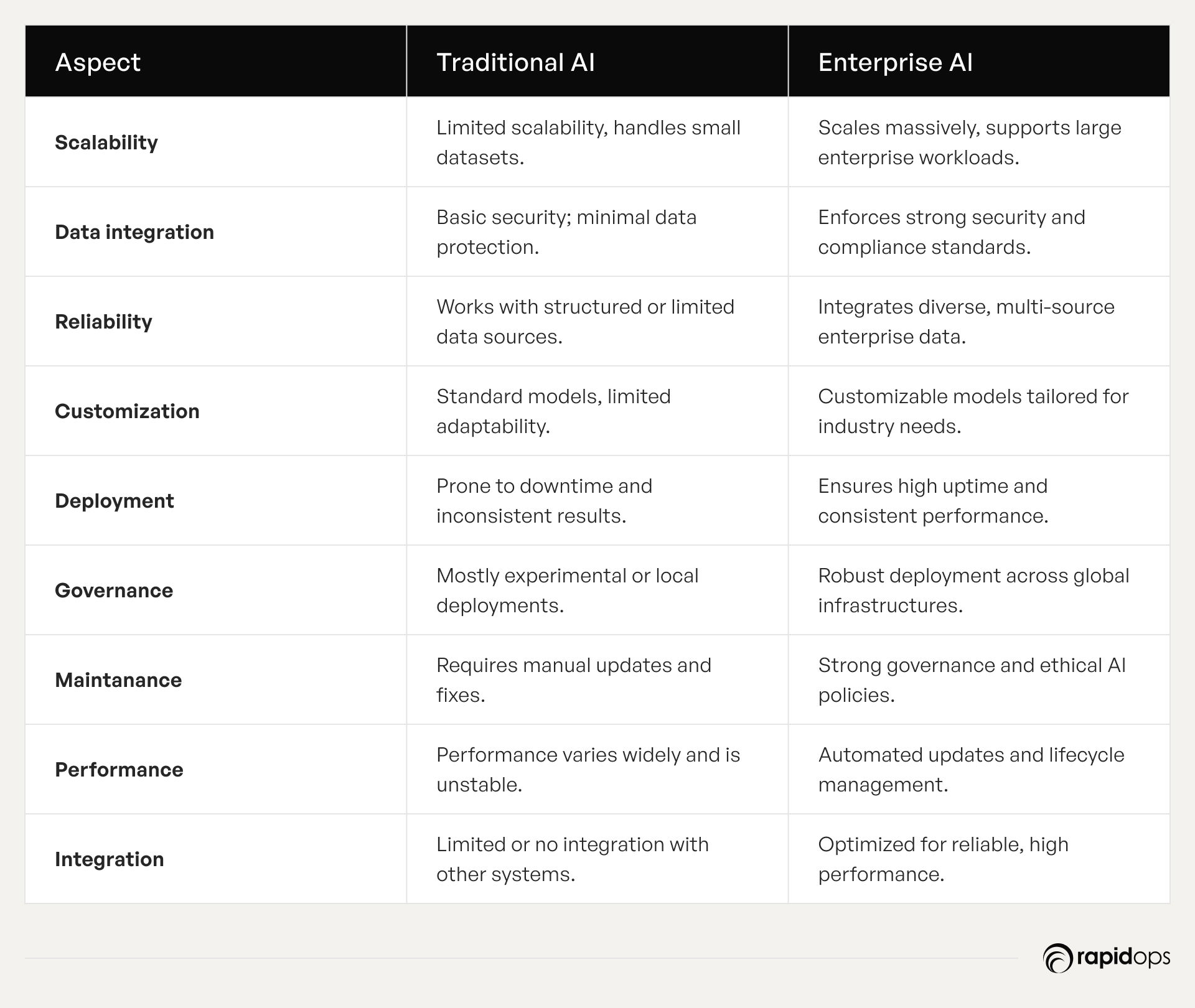
Traditional AI systems were developed for narrow, task-specific applications such as image recognition, text classification, or chatbot responses. These models often function in silos, operate on limited datasets, and lack the scalability, reliability, and integration required in complex enterprise environments. As a result, most implementations remain experimental or confined to departmental pilots, offering only incremental value without broader business impact.
Enterprise AI, on the other hand, is architected to meet the strategic and operational demands of modern businesses. It integrates diverse AI models, real-time data streams, cloud-native infrastructure, and enterprise-grade governance to deliver consistent, scalable outcomes. These systems are not just accurate; they are accountable, secure, and aligned with enterprise objectives, delivering tangible impact across functions such as operations, customer service, compliance, and forecasting.
In essence, traditional AI solves isolated problems. Enterprise AI transforms how organizations operate, embedding intelligence into workflows, accelerating decisions, and turning data into a competitive advantage at scale.
How enterprise AI goes beyond tools and becomes a system of intelligence
Enterprise AI is not a tool it’s a system of intelligence that spans the organization. It unifies data, decisions, and actions through intelligent automation and continuous learning.
Think of it as an evolving layer that sits on top of core business systems, analyzes signals from across the value chain, and enables proactive, context-aware responses at scale through AI agent development. This intelligence layer allows businesses to move from reactive operations to anticipatory, self-optimizing systems that evolve in real time.
By shifting AI from a technical initiative to a strategic operating layer, organizations unlock not just efficiency but competitive differentiation.
Core components of enterprise AI
Behind every intelligent enterprise is a deliberate architecture, where purpose-built models, governed data, scalable infrastructure, and ethical oversight work in harmony. These are not standalone tools; they are the integrated building blocks that shape how AI becomes a core enabler of business strategy, agility, and innovation.
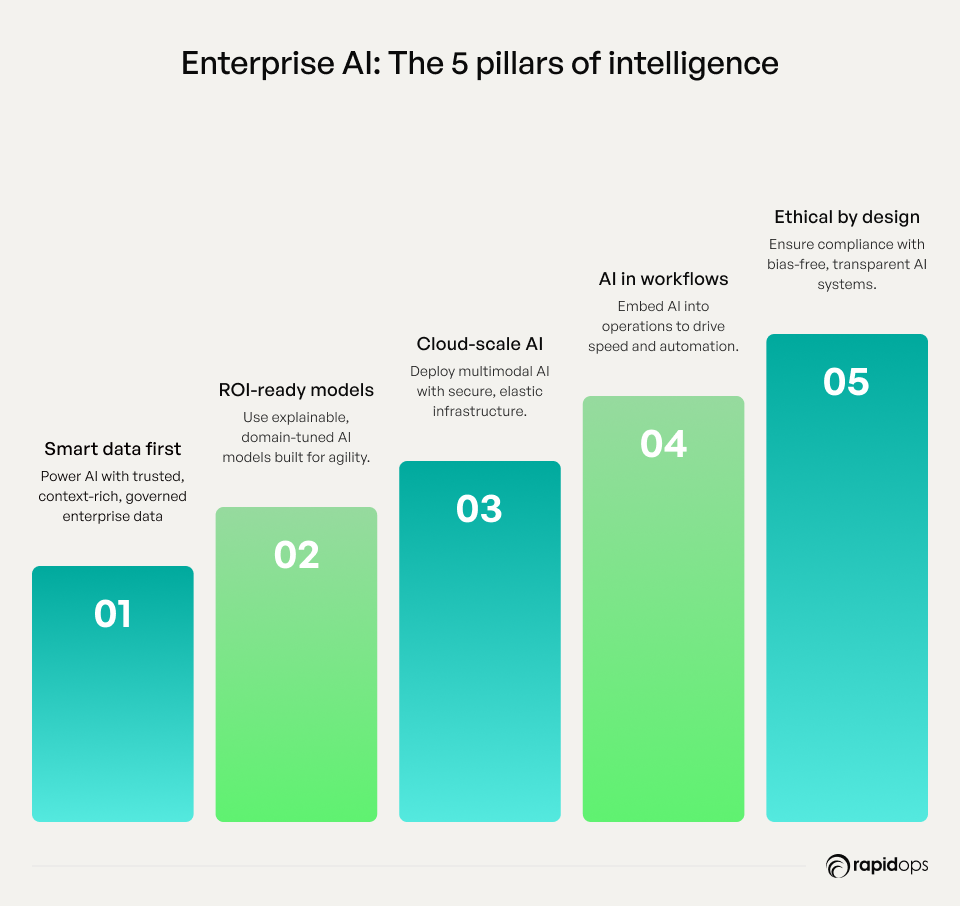
1. Data: The fuel behind intelligence
High-quality, integrated, and context-rich data is the lifeblood of enterprise AI. From structured records to unstructured logs, it powers model accuracy, decision quality, and long-term adaptability. Without enterprise-grade data pipelines and stewardship, even the most advanced models can underperform.
2. AI models: Built for business outcomes
These aren’t generic algorithms. Enterprise-grade models are fine-tuned for specific domains like demand forecasting, personalization, fraud detection, and more. They must be explainable, scalable, and resilient to changes in business signals and data patterns.
3. Infrastructure: Scalable, secure, cloud-native
AI must run on infrastructure that supports distributed computing, real-time inference, and multimodal processing. Enterprises require elastic, secure, and interoperable environments that span geographies and integrate with legacy and cloud-native systems alike.
4. Workflows: Embedding intelligence where it matters
AI delivers true value when it’s embedded directly into business operations, not added as an afterthought. Enterprise workflows must be reimagined with AI decision points that drive automation, personalization, and speed.
5. Governance: Responsible by design
Transparency, fairness, and compliance aren’t optional. Enterprise AI must be governed with clear frameworks for bias detection, auditability, and ethical decision-making from development through deployment.
When these elements function as a connected system, they don’t just enhance performance; they redefine it. Enterprise AI becomes a living framework that evolves with your business, adapts to complexity, and powers confident decision-making at scale. This is how intelligence moves from concept to competitive advantage.
Why enterprise AI matters for modern businesses
The future of business won't be shaped by who has the most data, but by who makes the smartest decisions with it. In a world where advantages are fleeting and disruption is constant; Enterprise AI turns intelligence into the most valuable form of infrastructure. It enables organizations not just to adapt, but to anticipate, act with clarity, and lead with confidence in moments that matter most.
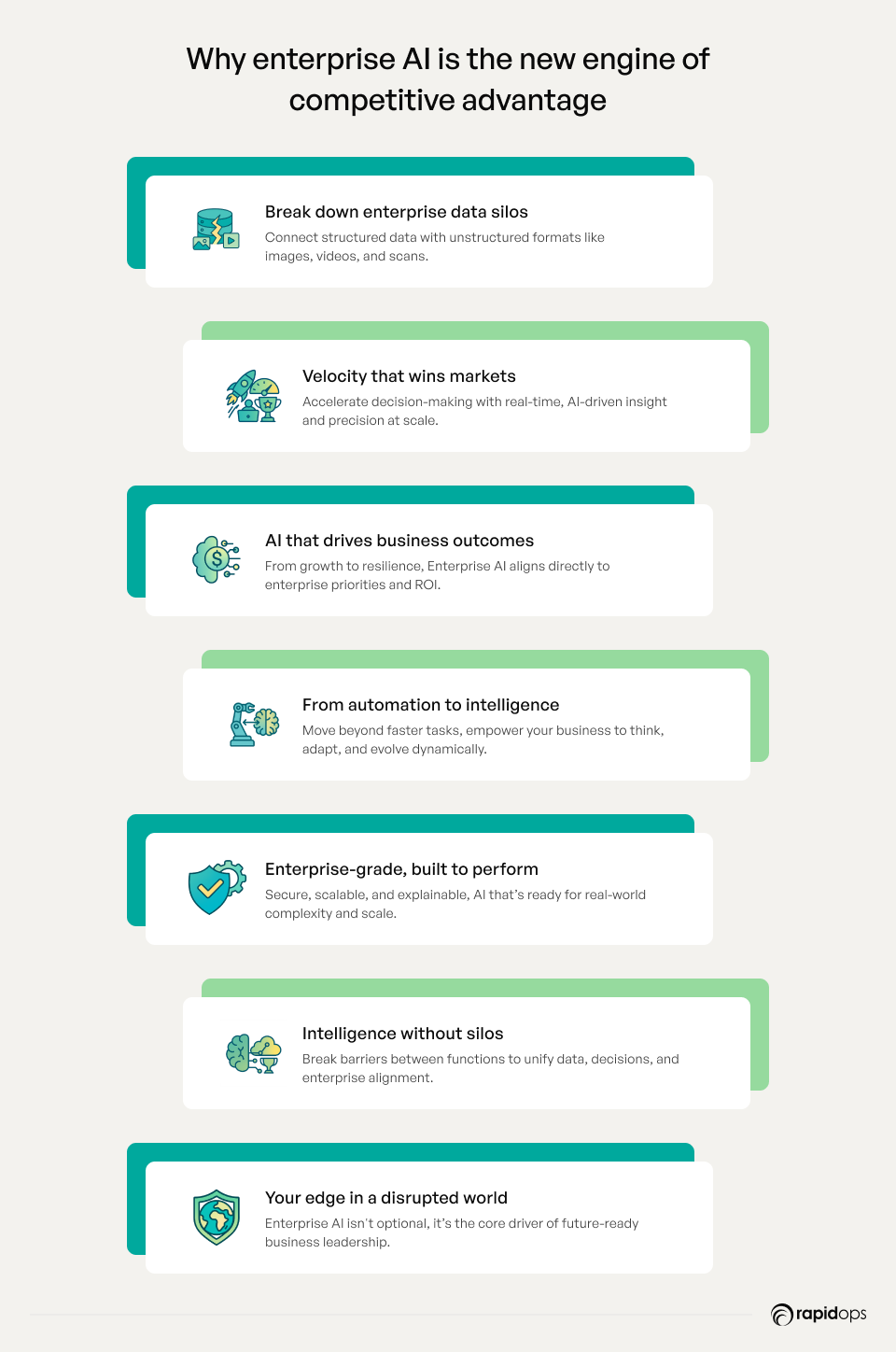
AI-driven decision velocity
The speed and precision of decision-making are now defining competitive advantage. Enterprise AI accelerates how fast businesses sense, interpret, and act on complex signals, from customer behavior to market shifts. With AI, decision-making is no longer reactive; it’s real-time, contextual, and confident. This velocity enables leaders to seize emerging opportunities, minimize risk, and stay ahead of disruption. Whether it’s dynamic pricing, supply adjustments, or personalization, organizations that can decide faster and smarter will lead to the future.
Strategic business value creation
Enterprise AI creates value not just by automating tasks but by aligning directly to business outcomes. When thoughtfully embedded, it drives:
- Growth through hyper-personalized customer experiences
- Profitability via AI-optimized pricing, service delivery, and resource allocation
- Innovation by uncovering patterns and opportunities from massive data sets
- Resilience through proactive sensing and agile response mechanisms
This value is systemic and cumulative, improving over time as systems learn, adapt, and align more deeply with enterprise priorities.
From automation to intelligence
While the early adoption of AI focused on eliminating manual processes, enterprise AI redefines the relationship between automation and intelligence. It's not about doing tasks faster; it's about enabling the business to think, decide, and act with greater precision.
Enterprise AI systems interpret patterns, forecast outcomes, and optimize in real-time. Supply chains dynamically rebalance. Marketing strategies evolve automatically. Service operations respond with contextual relevance. The result is a shift from static automation to adaptive intelligence that serves the entire enterprise.
Built for scale, security, and complexity
Enterprise AI isn't consumer-grade. It's engineered for the demands of mission-critical environments. It operates across petabyte-scale data, strict compliance mandates, and hybrid architectures. It must support real-time inference, ensure high availability, and meet rigorous governance standards. From auditability to explainability, enterprise AI is built to perform in industries where accuracy, trust, and uptime are non-negotiable.
Connected intelligence across silos
A defining strength of enterprise AI is its ability to unify intelligence across silos. It links customer behavior with supply forecasts, financial trends with marketing outcomes, and operations with workforce readiness.
This integrated intelligence enables faster cross-functional decisions, improved collaboration, and a shift from reactive to predictive business models. When intelligence flows freely, enterprises gain agility, alignment, and a stronger sense of direction.
Proven business outcomes and ROI
Enterprise AI is generating a measurable impact. Organizations are increasing customer loyalty, reducing time-to-market, strengthening supply resilience, and making smarter, data-informed decisions. Beyond efficiency, the ROI includes greater adaptability, sustained growth, and enterprise-wide learning. The most successful organizations see AI not as a project or product, but as a foundational layer for enterprise performance.
Competitive edge in a rapidly evolving market
In a world defined by technological, economic, and geopolitical disruption, Enterprise AI offers a durable competitive edge. It empowers businesses to anticipate change, simulate strategic scenarios, and scale intelligence without compromising accuracy.
The result is not just operational readiness, but market leadership. Enterprise AI has moved from being a differentiator to a necessity. It turns data-rich organizations into decision-intelligent enterprises, capable of navigating the future with clarity and confidence.
Enterprise AI matters because it fundamentally changes the way business works. It's not about doing more things. It's about doing what matters faster, smarter, and on a scale.
What are the different types of enterprise AI?
True enterprise intelligence isn’t just adopting AI, it's understanding the specific types of enterprise AI that enable perception, prediction, generation, and autonomy. Distinguishing these capabilities is essential to lead with clarity and build meaningful, scalable intelligence.
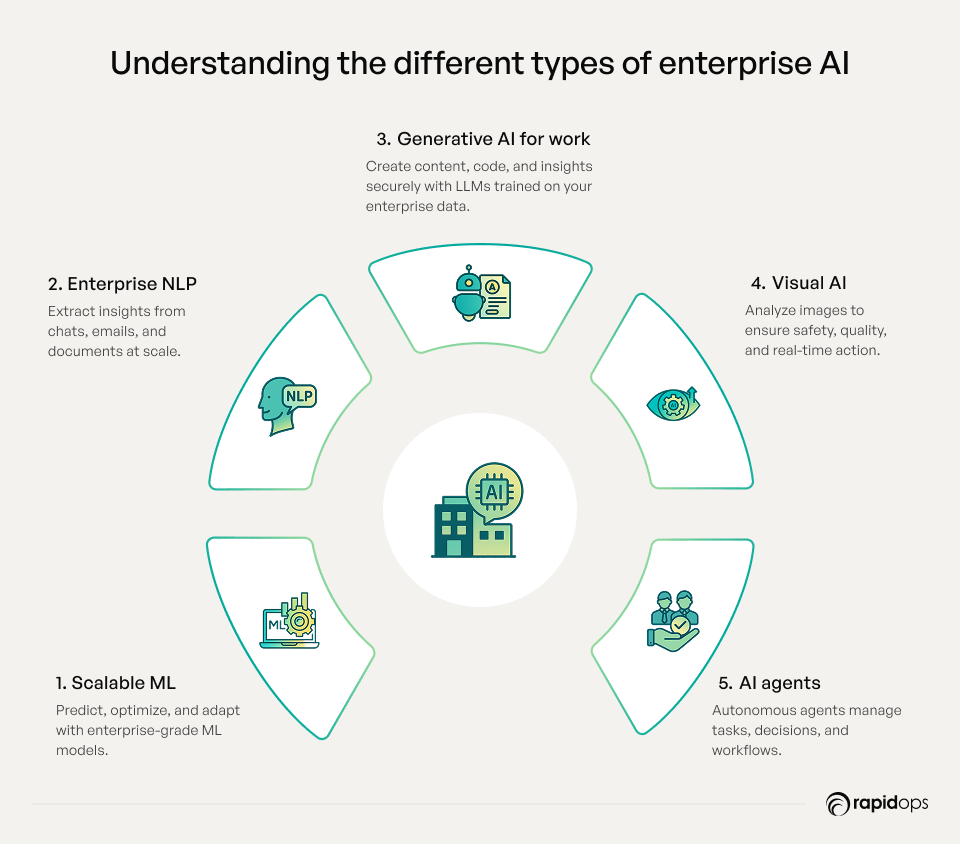
Machine learning & predictive analytics
Machine learning (ML) serves as the analytical engine of enterprise AI. These systems analyze structured and unstructured data to uncover patterns, detect anomalies, and predict outcomes. Predictive analytics, powered by ML, enable organizations to anticipate demand, forecast revenue, assess risk, and optimize performance with precision.
What makes it enterprise-grade is the ability to scale across geographies, integrate with systems like ERP or CRM, and operate under governance and compliance requirements. These models evolve continuously, supporting dynamic and context-aware decision-making.
Natural language processing (NLP)
Natural language processing bridges human language and machine intelligence. It allows enterprises to process, understand, and respond to unstructured data such as emails, chats, documents, and audio transcripts at scale. NLP enables capabilities like intelligent search, summarization, sentiment analysis, and conversational AI.
At the enterprise level, it must support domain-specific vocabularies, multiple languages, and secure handling of sensitive information. NLP transforms communication into actionable intelligence, accelerating workflows and improving decision quality.
Generative AI (Including LLMs & copilots)
Generative AI introduces the ability to create content text, code, designs, reports, and more, based on contextual prompts. Powered by large language models (LLMs), it supports copilots that assist knowledge workers by summarizing information, drafting responses, generating ideas, and automating document generation through specialized LLM development services.
Unlike consumer-facing tools, enterprise generative AI systems are trained on proprietary data, governed for traceability, and integrated with core platforms. This ensures outputs are relevant, secure, and aligned with the business context.
Computer vision
Computer vision enables machines to interpret and act on visual data, including images, videos, and spatial environments. In enterprise settings, it powers quality control in manufacturing, safety monitoring in facilities, and shelf analytics in retail. These systems combine edge computing, AI inference, and real-time decision logic to translate visual inputs into operational intelligence. Enterprise computer vision solutions must meet high accuracy thresholds, integrate with physical infrastructure, and comply with industry-specific regulations.
AI agents and autonomous systems
AI agents represent the most advanced form of enterprise AI, systems that can perceive context, reason through options, and take autonomous actions. Unlike traditional automation, these agents operate with goal-directed logic, adapt to dynamic environments, and interact with APIs, databases, and human teams.
They are used to orchestrate end-to-end workflows, manage complex decisions, and drive autonomous processes in areas like IT operations, procurement, and customer service. Enterprise AI agents are governed by robust policies, ensuring accountability, auditability, and alignment with strategic goals.
Understanding the types of enterprise AI isn’t just about classification; it’s about clarity. Each capability represents a distinct level of intelligence that empowers your organization to adapt faster, decide smarter, and lead with confidence in a world shaped by continuous innovation.
What are the core capabilities of enterprise AI
Enterprise AI isn’t defined by a single breakthrough; it’s built through a constellation of capabilities that rewire how value is created at scale. From perception to prediction, and automation to augmentation, these capabilities empower enterprises to transform intelligence into action, insight into advantage, and complexity into clarity.
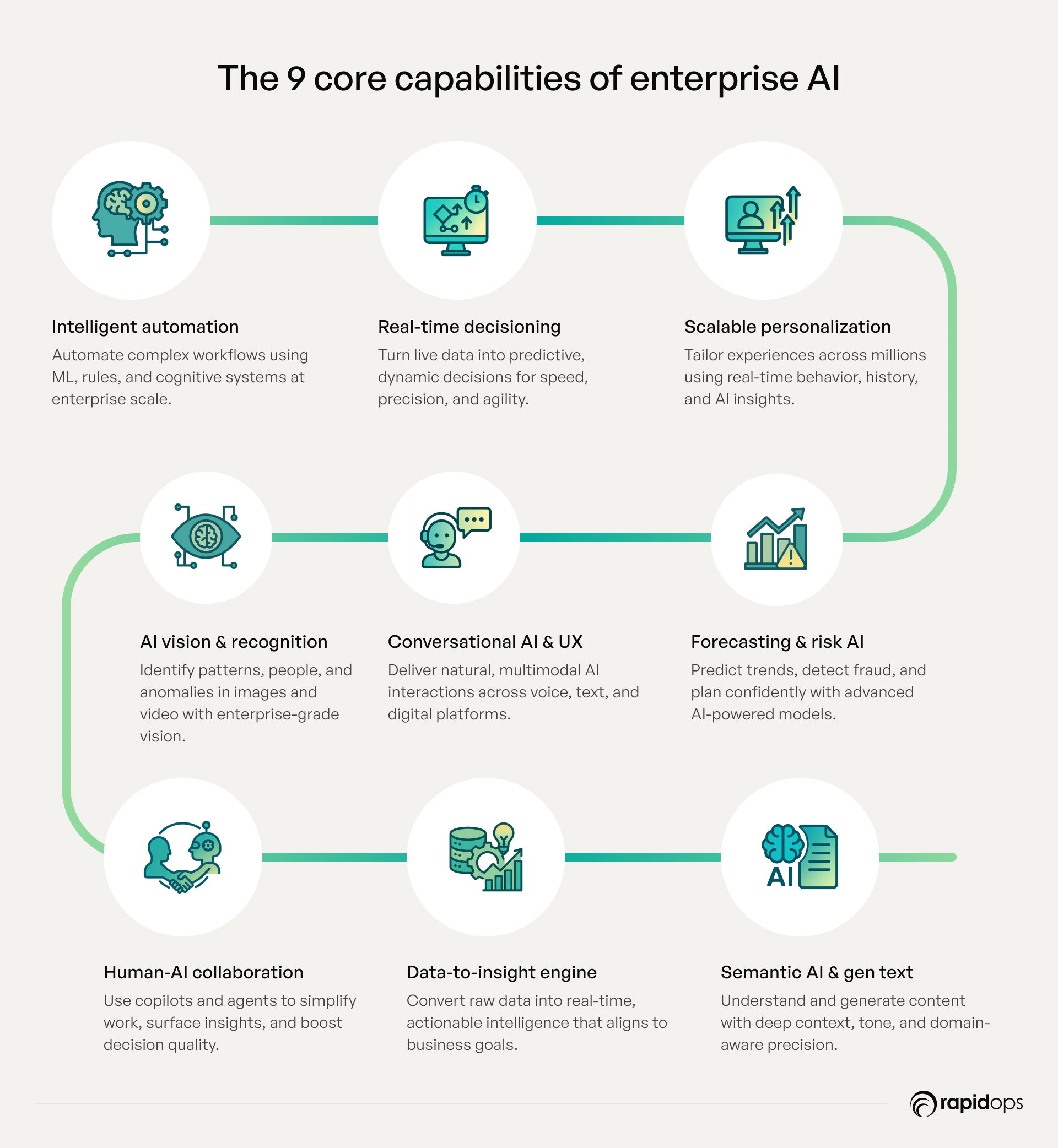
Intelligent process automation
At its core, enterprise AI automates complex business processes using machine learning, rule-based systems, and cognitive techniques. This extends beyond routine task automation to intelligently handle unstructured data, dynamic exceptions, and evolving workflows. Intelligent automation reduces operational friction, increases compliance, and establishes a responsive, AI-powered operational backbone that scales with evolving enterprise demands.
Real-time decision intelligence
This capability enables organizations to shift from retrospective analysis to proactive, data-driven decision-making. By continuously processing real-time data and applying predictive and prescriptive analytics, enterprises gain the ability to respond dynamically, whether managing risk, optimizing financial operations, or rebalancing supply chains. Timing and precision become strategic advantages.
Personalized experiences at scale
AI-driven personalization leverages behavioral signals, historical data, and real-time context to tailor interactions across channels. Whether recommending products, curating content, or guiding service journeys, personalization at scale deepens customer engagement, drives conversion, and boosts retention while maintaining efficiency and relevance across millions of interactions.
Advanced forecasting and risk management
AI enables enterprises to anticipate change with confidence. Sophisticated models process high-dimensional data from macroeconomic indicators to operational signals to deliver forward-looking insights. These capabilities support accurate demand planning, fraud detection, credit scoring, and regulatory compliance, empowering leaders to make informed decisions under uncertainty.
Conversational AI and multimodal interactions
Conversational AI brings natural language understanding into digital channels, enabling intelligent assistants to resolve issues, answer questions, and assist employees across text, voice, and multimodal interfaces. These systems interpret intent and emotion to deliver intuitive, context-aware interactions that elevate user experiences and reduce support overhead.
Object recognition and computer vision
Computer vision powers intelligent visual understanding recognizing objects, people, defects, or movements in images and video. In enterprise environments, it supports use cases such as quality assurance in manufacturing and shelf analytics in retail. High accuracy, real-time responsiveness, and compliance with governance standards define enterprise-grade applications.
Human-AI collaboration through copilots and agents
AI copilots and agents augment human decision-making by surfacing insights, automating context-aware actions, and simplifying complex workflows. Embedded within enterprise platforms, they reduce cognitive load and increase productivity. Governed by secure, auditable frameworks, these collaborative systems elevate human potential while maintaining accountability and control.
Data-to-insight conversion
Turning data into actionable insight is foundational to enterprise AI. This capability spans automated data ingestion, feature engineering, and real-time analytics, delivering trustworthy intelligence from vast, varied data sources. It ensures that AI systems continuously learn, adapt, and remain aligned with evolving business goals.
Semantic understanding & language generation
Enterprise AI systems are now capable of deep language understanding, interpreting meaning, tone, and nuance and generating human-like content. These capabilities support regulatory reporting, executive summaries, content generation, and automated knowledge extraction. When integrated across systems, they enhance collaboration and unlock value from previously untapped unstructured data.
Together, these capabilities form the essential building blocks of enterprise AI. Leaders who strategically orchestrate them won’t just improve operations, they’ll build intelligent, adaptive organizations equipped to thrive in complexity, seize emerging opportunities, and lead with clarity in an increasingly AI-powered business landscape.
What is the ideal architecture that enterprise AI requires?
Enterprise AI relies on a purposeful architecture, one that’s unified, scalable, and secure. It’s this foundation that enables AI to operate seamlessly, deliver consistent value, and power intelligent decisions across complex enterprise systems.
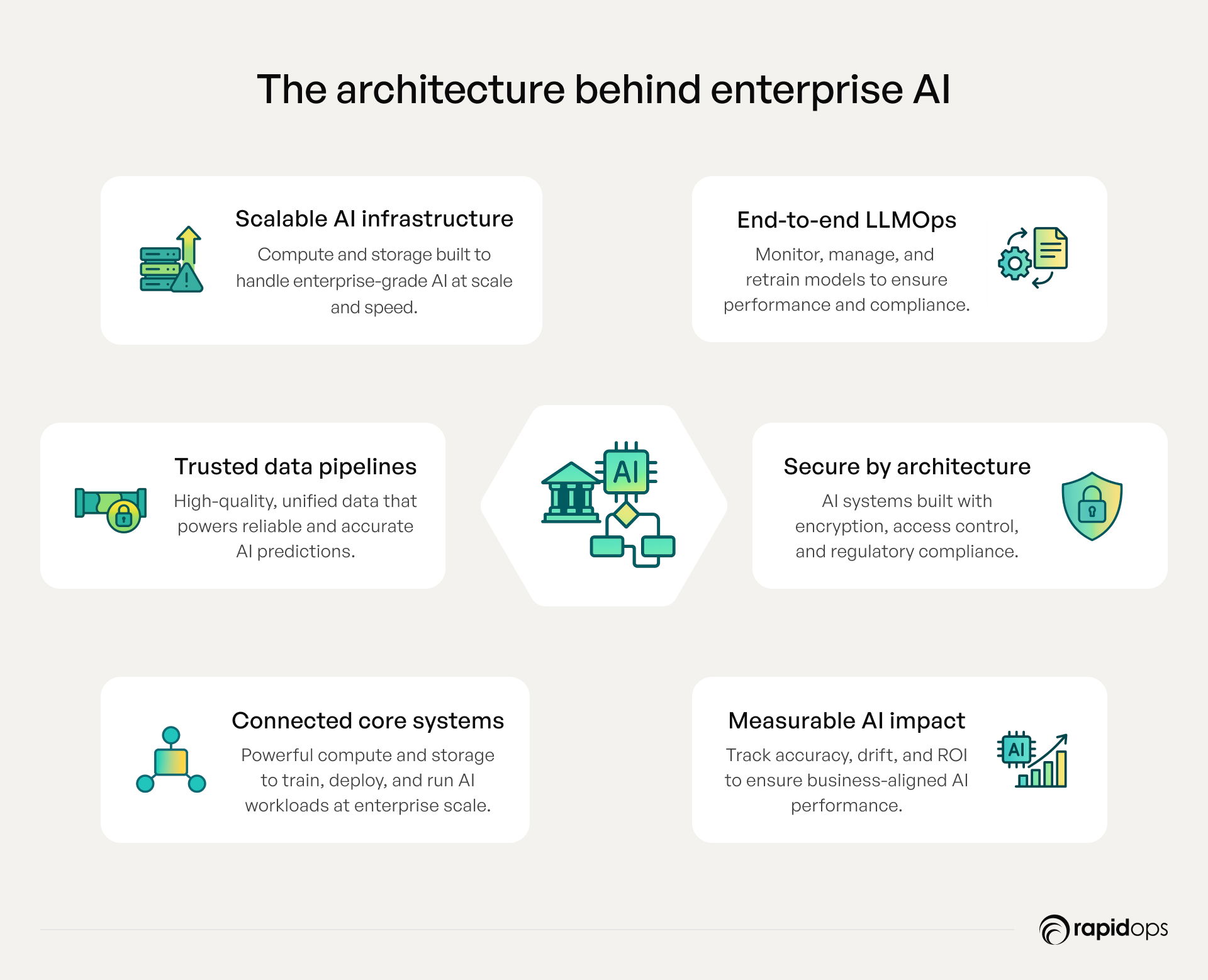
Scalable infrastructure
AI workloads require significant compute and storage capabilities. Whether delivered via public cloud, private cloud, or on-prem environments, enterprises need infrastructure that can scale with demand, handle high-throughput data, and support fast inference. Without this flexible backbone, training and deploying AI models at enterprise scale is not feasible.
Centralized and governed data foundation
Data is the lifeblood of AI. A unified, high-quality, and accessible data layer, typically through a data lake, warehouse, or lakehouse, is critical. AI systems rely on structured, cleaned, and governed data pipelines that enable learning, reasoning, and prediction. Without a centralized and compliant data environment, AI cannot generate accurate or trusted insights.
Integration with core business systems
AI must be deeply embedded in day-to-day operations to be effective. Seamless connectivity with ERP, CRM, SCM, EHR, and other enterprise platforms through APIs and middleware ensures that models operate on real-time inputs and trigger relevant actions. Integration is what turns AI insights into execution and outcomes.
Model lifecycle management
AI isn’t a one-time deployment; it’s a continuous cycle. Enterprises need lightweight LLMOps capabilities and domain-specific LLM development to deploy, monitor, retrain, and version models effectively. Refining pre-trained large language models on enterprise-specific data ensures alignment with business context, compliance standards, and performance benchmarks. Even at a basic level, these workflows ensure that AI stays relevant, adaptive, and high-performing over time.
Built-in security and compliance
Enterprise AI must be trusted by design. This means embedding identity and access control, encryption, data lineage tracking, and model transparency from the ground up. Especially in regulated industries, AI must meet compliance standards and adhere to ethical governance principles. Security isn’t a feature; it’s foundational.
Performance monitoring and alignment
AI success depends on whether it delivers measurable business outcomes. Enterprises need a clear layer of monitoring for model performance, drift, and ROI, even if it starts with simple dashboards. This observability ensures that AI stays relevant, improves over time, and continuously supports strategic goals.
How is enterprise AI resolve real business challenges
Enterprise AI isn’t just a capability; it’s a catalyst for transformation. It elevates critical business functions by turning data into intelligent decisions, automation into agility, and insights into meaningful action. For today’s business leaders, understanding how these powers deliver measurable outcomes is key to advancing with clarity and purpose.
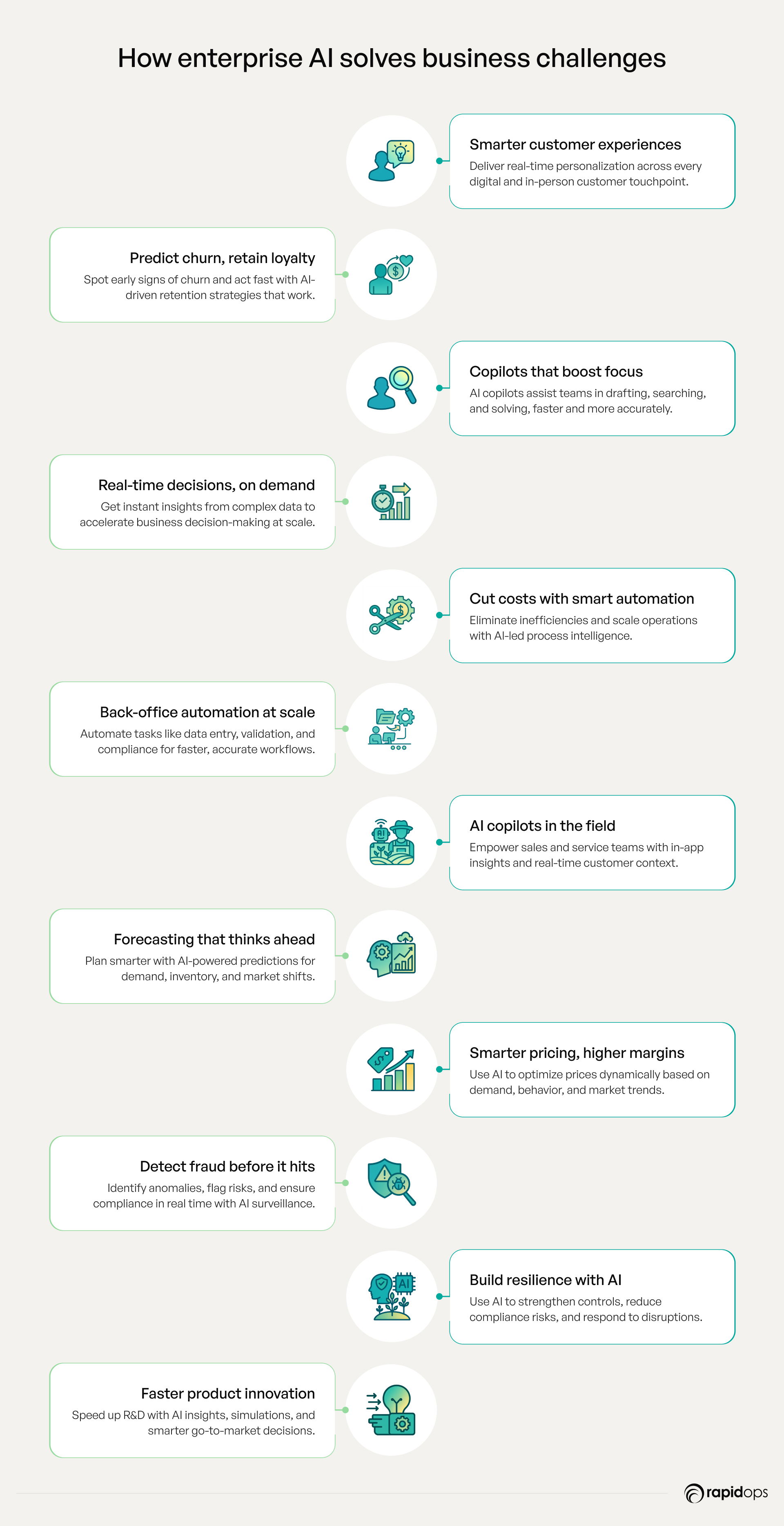
1. Personalizing customer experiences at scale
Enterprise AI enables real-time personalization across every digital and physical channel by analyzing structured and unstructured customer data, behavioral patterns, transaction history, preferences, and feedback loops. By continuously learning from interactions, AI orchestrates dynamic experiences such as individualized content, proactive support, and predictive engagement, thereby improving satisfaction and long-term loyalty.
2. Predicting customer churn and improving retention
By analyzing behavioral patterns, engagement metrics, and sentiment signals, enterprise AI identifies early indicators of customer dissatisfaction or disengagement. This enables marketing and service teams to proactively intervene with tailored retention strategies, improving customer lifetime value.
3. Boosting workforce productivity with AI-powered copilots
AI copilots are reshaping how work gets done, augmenting teams with real-time assistance for tasks like document drafting, contextual search, insight summarization, and knowledge retrieval. By embedding these copilots into everyday workflows, businesses unlock significant gains in speed, accuracy, and focus. Many enterprises are now leveraging generative AI software development services to build domain-specific copilots that align with their systems, data, and roles, turning repetitive work into intelligent, adaptive support.
4. Accelerating decision-making with real-time insights
Enterprise AI delivers intelligence at the point of decision by integrating data from diverse systems and applying advanced analytics models. Leaders gain on-demand access to scenario analysis, risk scoring, and recommendation engines that support both tactical responses and long-term strategic planning. This enables faster, more informed decisions aligned with business goals.
5. Reducing operational costs through intelligent automation
By identifying inefficiencies in business processes, enterprise AI automates repetitive, rule-based operations with contextual logic and adaptive workflows. This not only reduces labor costs and process delays but also improves consistency and accuracy. AI-enabled automation minimizes operational overhead and allows for greater scalability without proportional increases in resource needs.
6. Automating core back-office workflows
Enterprise AI enhances the efficiency and governance of core transactional processes by automating document classification, data entry, validation, and compliance checks. It ensures accuracy, audit readiness, and process traceability, reducing reliance on manual oversight while supporting speed, standardization, and cost containment.
7. Enabling AI copilots across sales, service, and field ops
AI copilots empower frontline and customer-facing teams by delivering contextual intelligence directly within CRM, support, or field applications. These systems surface real-time insights like purchase history, issue summaries, or predictive service recommendations, enabling more effective interactions, quicker resolutions, and stronger relationships across the customer lifecycle.
8. Improving forecasting and demand planning
AI models synthesize historical trends, market signals, and operational data to provide granular, near-real-time forecasts. These forecasts enhance production planning, inventory allocation, and procurement strategies. Enterprise AI ensures that planning decisions are responsive, data-driven, and dynamically updated in response to external or internal shifts.
9. Optimizing pricing and revenue management
AI models help enterprises dynamically optimize pricing strategies by evaluating demand elasticity, competitor movements, historical sales, and customer segments. This leads to increased margins, reduced discounting, and better alignment between pricing and perceived value.
10. Enhancing fraud detection and risk mitigation
Enterprise AI continuously monitors transactional and behavioral data to identify unusual activity, enforce compliance thresholds, and adapt to evolving risk patterns. These systems are built to operate at scale and in real-time, making them integral to financial integrity, cybersecurity, and regulatory compliance across high-risk enterprise environments.
11. Strengthening business resilience and compliance
By continuously assessing enterprise-wide processes, policies, and controls, AI helps organizations identify vulnerabilities, ensure adherence to regulatory frameworks, and maintain continuity during disruptions. Automated alerts, self-auditing logs, and predictive risk indicators enable preemptive action, turning compliance from a reactive burden into a proactive strength.
12. Accelerating product innovation and time to market
Enterprise AI supports R&D and product teams with tools to analyze market trends, simulate product performance, and accelerate prototyping. By reducing iteration cycles and improving decision accuracy in development phases, organizations can bring new offerings to the market faster and with greater confidence.
Enterprise AI use cases in retail, manufacturing, and distribution
Enterprise AI is now a core enabler of competitive advantage across industries. No longer confined to innovation centers, it is actively transforming operational workflows, customer engagement, and strategic decision-making at a scale. The following use cases demonstrate how organizations are embedding intelligent systems to deliver measurable, business-critical outcomes.
Retail: Smarter journeys, personalized at scale
The shift to enterprise AI is enabling more intelligent, connected, and profitable customer experiences. With customer journeys becoming increasingly fragmented across physical and digital channels, retailers face mounting pressure to anticipate individual needs, respond to real-time demand shifts, and deliver consistent engagement across touchpoints all while protecting margins.
Enterprise AI empowers retailers with capabilities like hyper-personalized targeting using behavioral analytics, dynamic pricing engines that react to competitor moves and stock levels, and omnichannel orchestration that aligns inventory, marketing, and service. These systems don’t just automate they adapt in real time, helping retail leaders reduce cart abandonment, improve inventory turnover, and elevate loyalty by making every interaction smarter and more context-aware.
Manufacturing: Intelligent production, predictive precision
Enterprise AI is unlocking a new level of operational intelligence across the production lifecycle. As manufacturers confront the dual challenge of optimizing asset performance and meeting stringent quality and sustainability standards, AI provides the ability to sense, analyze, and act across machines, lines, and facilities.
Predictive maintenance models reduce downtime by identifying early failure signals in IoT sensor data. AI-powered computer vision ensures quality through real-time defect detection, while intelligent energy management systems drive efficiency and environmental gains. These capabilities create a more agile, cost-effective, and resilient production environment, where decisions are proactive, processes are self-optimizing, and output quality is consistently high.
Distribution: AI-driven fulfillment with real-time agility
Enterprise AI is transforming fulfillment networks into intelligent ecosystems. Distributors must now deliver faster, adapt to demand variability, and reduce last-mile complexity without compromising cost-efficiency. AI tackles these challenges through advanced demand forecasting, intelligent warehouse automation, and dynamic route optimization that accounts for fleet, traffic, and delivery windows in real time.
Intelligent load planning improves vehicle utilization, while anomaly detection ensures SLA adherence and minimizes disruptions. These enterprise AI-driven workflows help distribution leaders scale with precision, respond rapidly to shifting logistics realities, and build fulfillment networks that are not only efficient, but resilient and deeply customer-centric.
What enterprises need to consider while adopting enterprise AI
Adopting enterprise AI reshapes how an organization thinks, operates, and competes. Beyond algorithms, it requires aligning people, systems, and strategy, making the groundwork you lay today the real driver of tomorrow’s outcomes.
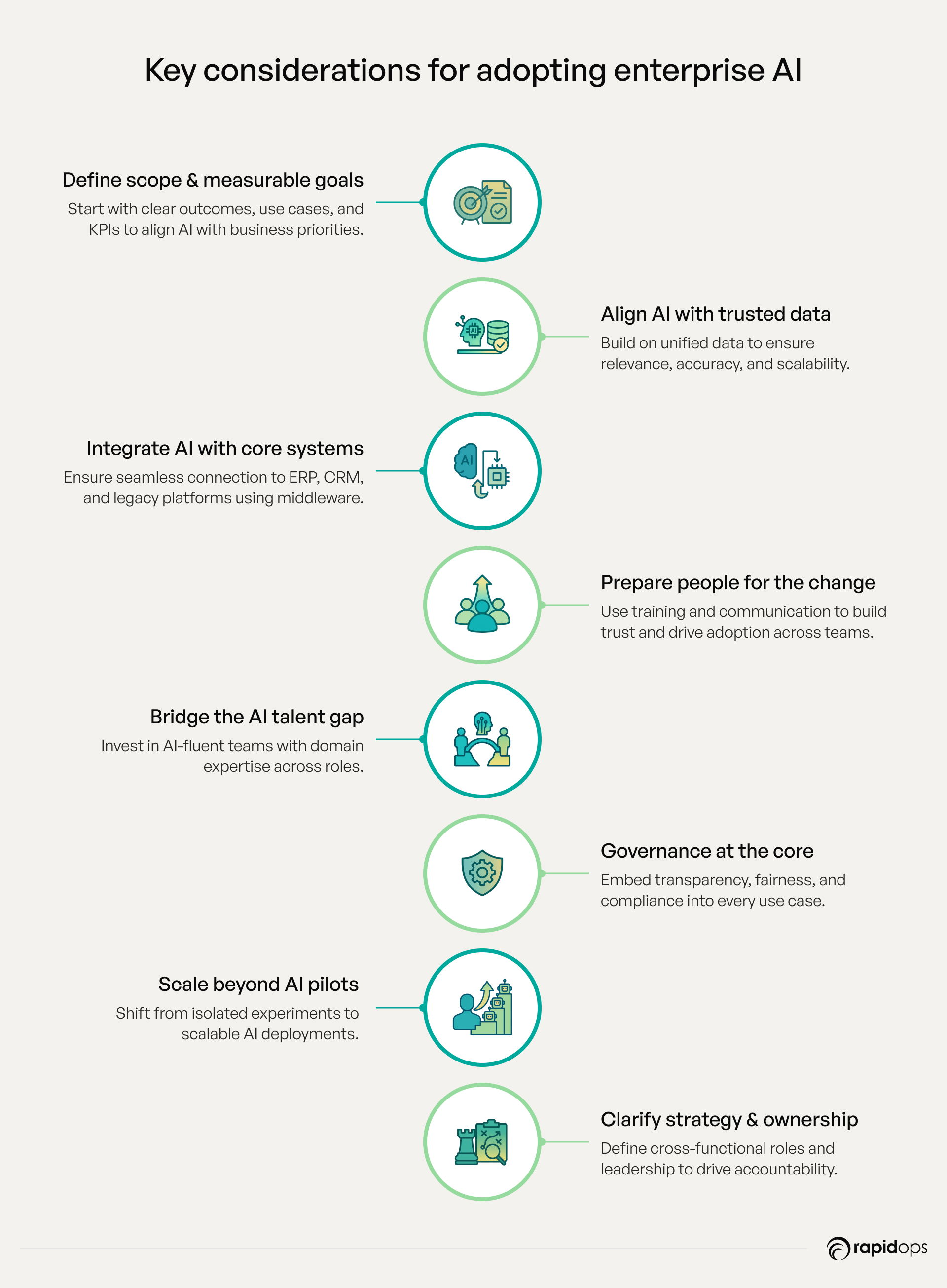
1. Identifying clear scope, purpose, and measurable outcomes
Before deploying models or integrating platforms, enterprises must define why AI is being adopted and what success looks like. Is the goal to optimize operations, personalize customer experiences, reduce risk, or all of the above? Clarity around business objectives, target use cases, and KPIs ensures that AI investments stay focused, measurable, and aligned with enterprise strategy, not just experimentation.
2. Aligning AI with unified, trusted data
AI systems thrive on high-quality, accessible, and well-governed data. Fragmented data sources, siloed architectures, and inconsistent taxonomies hinder the effectiveness of AI models. A unified data foundation is essential, not only for accuracy and relevance but for operationalizing AI at scale across the enterprise.
3. Integrating AI within existing ecosystems
Legacy systems and disconnected infrastructure can slow AI adoption. Enterprises must ensure AI solutions are compatible with their current ERP, CRM, SCM, or EHR platforms. A clear integration strategy using APIs, middleware, or modern data fabrics lays the groundwork for seamless data and insight flow.
4. Navigating change across people and processes
AI changes how people work. Without proactive change management, even the best solutions may face resistance. Clear communication, structured training, and cross-functional alignment help teams embrace AI, fostering a culture of augmentation rather than replacement.
5. Closing the AI talent and skill gap
AI success requires more than data scientists. It demands multidisciplinary teams, including domain experts, ML engineers, AI product managers, and operational leads. Enterprises must invest in upskilling talent, partnering with experts, and cultivating AI fluency across roles.
6. Embedding governance, ethics, and compliance by design
From model bias to data privacy, AI introduces new layers of responsibility. Businesses need robust frameworks for governance covering transparency, auditability, fairness, and legal compliance, across every model and use case. This ensures trust, regulatory alignment, and long-term resilience.
7. Moving beyond pilots to scalable value
Many organizations stall after initial AI pilots due to unclear objectives or lack of operationalization pathways. Instead of isolated proofs-of-concept, enterprises should define success metrics upfront, build reusable pipelines, and connect AI outcomes to business impact from the start.
8. Defining clear strategy, ownership, and accountability
AI isn’t just an IT project; it’s an enterprise-wide capability. Success depends on cross-functional leadership, well-defined roles (e.g., Chief AI Officer, AI CoE), and a clear roadmap aligned with strategic goals. Without centralized oversight, fragmentation and misalignment are inevitable.
From understanding to action
Now you know what enterprise AI is, and why it’s becoming a strategic cornerstone for how modern businesses simplify complexity, improve agility, and unlock growth.
For many organizations in retail, manufacturing, and distribution, the challenge isn’t understanding AI’s potential; it’s knowing how to apply it meaningfully across teams, systems, and processes. That’s where real transformation happens when intelligence becomes part of how your business runs every day, not just a side project or proof of concept.
At Rapidops, we bring over 16 years of enterprise experience helping businesses move from early AI exploration to real-world execution. Our team helps design and deliver solutions that are built around your unique business needs, with architecture, data, and workflows aligned to create lasting value, not technical debt.
If you're ready to explore how enterprise AI can solve your current challenges, we’re here to guide you with clarity and experience. Book a free consultation with one of our AI experts, we’ll help you uncover the right use cases, assess your readiness, and outline a smart path forward.
Frequently Asked Questions
How do I know my business is ready for enterprise AI?
You’re ready for enterprise AI when your business is generating meaningful data but struggling to turn it into real-time decisions, personalized experiences, or operational efficiency. If your teams are spending more time gathering insights than acting on them or if existing systems can't scale with complexity, then it’s time to consider AI not as a future investment, but as a present enabler of performance, speed, and growth.
What is the difference between AI and enterprise AI?
Traditional AI is typically task-specific, working in silos to automate narrow functions like chatbots or image recognition. Enterprise AI, by contrast, is a system-wide capability. It’s designed to integrate across departments, operate securely at scale, and align directly with business objectives combining models, data pipelines, and governance into a cohesive, strategic layer that drives measurable business outcomes.
Is enterprise AI only for large businesses, or can mid-sized companies use it too?
Enterprise AI is no longer limited to large corporations. Mid-sized companies are adopting it to streamline operations, personalize customer experiences, and make data-driven decisions, often faster than their larger counterparts. Cloud-native platforms and modular architectures make it accessible and scalable, enabling mid-sized enterprises to deploy what they need, when they need it, without overhauling their entire infrastructure.
Does enterprise AI require a complete overhaul of existing systems?
No. The strength of enterprise AI lies in its ability to work within your existing ecosystem. Instead of replacing legacy systems, it enhances them, by layering intelligence on top of current platforms and workflows. With the right integration approach, AI can connect to CRMs, ERPs, supply chains, or other systems to amplify their impact without disrupting core operations.
Can enterprise AI work with legacy systems and on-premise data?
Yes. Modern enterprise AI solutions are designed with hybrid environments in mind. They can ingest and process on-premise data securely, interact with legacy systems via APIs or middleware, and operate in compliance-heavy settings. Whether your data resides in the cloud, on-premises, or across both, enterprise AI can adapt to your infrastructure, delivering value without forcing a full migration.

Rahul Chaudhary
Content Writer
With 5 years of experience in AI, software, and digital transformation, I’m passionate about making complex concepts easy to understand and apply. I create content that speaks to business leaders, offering practical, data-driven solutions that help you tackle real challenges and make informed decisions that drive growth.
What’s Inside
- Defining enterprise AI in strategic business terms
- Why enterprise AI matters for modern businesses
- What are the different types of enterprise AI?
- What are the core capabilities of enterprise AI
- What is the ideal architecture that enterprise AI requires?
- How is enterprise AI resolve real business challenges
- Enterprise AI use cases in retail, manufacturing, and distribution
- What enterprises need to consider while adopting enterprise AI
- From understanding to action

Let’s build the next big thing!
Share your ideas and vision with us to explore your digital opportunities
Similar Stories
- AI
- 4 Mins
- September 2022

- AI
- 9 Mins
- January 2023


Receive articles like this in your mailbox
Sign up to get weekly insights & inspiration in your inbox.

